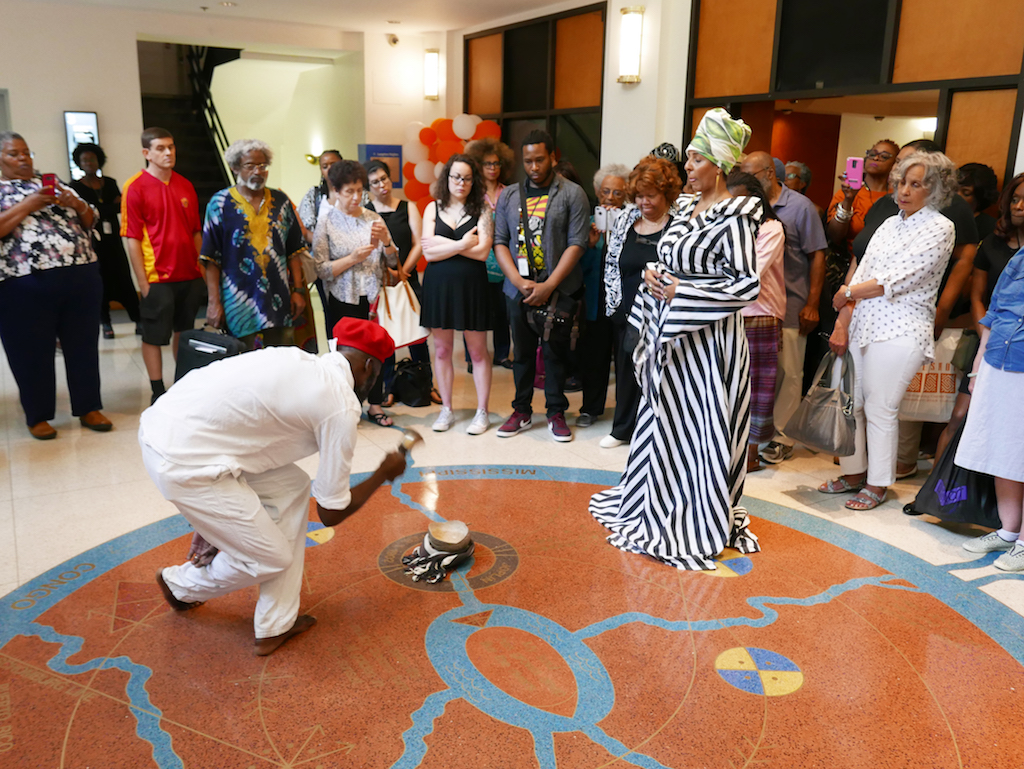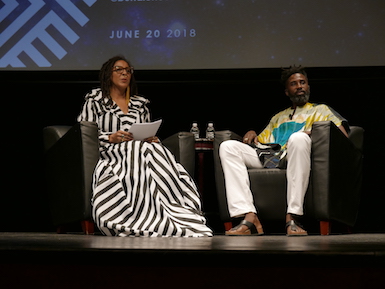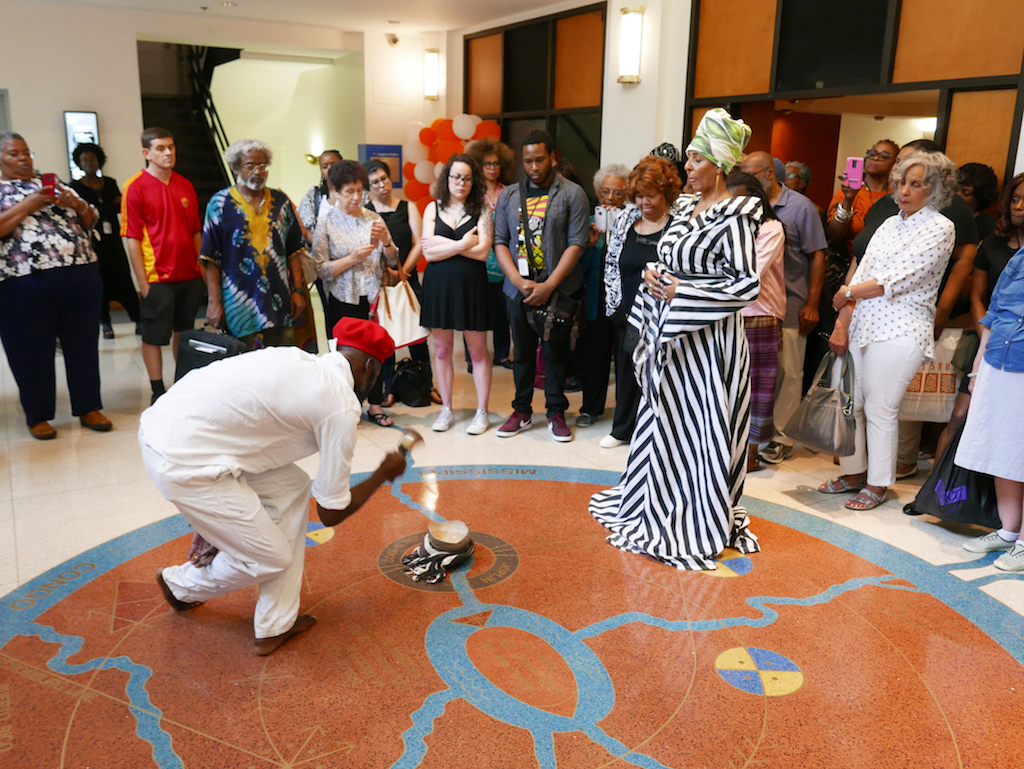[ad_1]

Nyugen E. Smith and D. Denenge Duyst-Akpem.
BOB GORE/COURTESY SCHOMBURG CENTER
Last week, attendees of an event at the Schomburg Center for the Study of Black Culture in Harlem stood over top a site-specific work of cosmogram art that serves as a connector to ancestral cultures and a tribute to the poet Langston Hughes. A rope blocked entry to the ultimate site of the gathering—for a talk titled “Consecrating the Cosmos: Masquerade, Performance and Spirituality in Carnival Traditions”—so bodies took up position over the curious work on the floor.
The cosmogram, created by the late artist Houston Conwill, is titled Rivers (1992), in tribute to Hughes’s poem The Negro Speaks of Rivers. It is also a burial site, with Hughes’s ashes underneath. Like cosmograms found in places like the Democratic Republic of the Congo, where ritualistic ground markings illustrate the spiritual continuity between life and death, the etchings in Rivers form arcs, concentric circles, and other geometric shapes set in a terrazzo landscape of time and space. The birthplaces of Hughes and the historian Arturo Alfonso Schomburg are marked in text, with gold lines representing their individual lives stemming from the geographical landmarks and converging in Harlem.
Over the din of voices waiting for a pre-talk performance entered the sound of deep breathing from a mouth right up against a microphone. Soon after, the New York-based artist Nyugen E. Smith appeared, slowly ascending a staircase in white linens and a red felt hat. Every few steps, he rang a bell. D. Denenge Duyst-Akpem, a self-identified Afrofuturist space sculptor and performance artist, followed in a floor-length dress she made herself, with a bowl of water rested on a wrapped cloth. Both followed one of the blue “river” etchings to the center of the cosmogram, where Duyst-Akpem wet her fingertips and sent specks of water into the audience. Smith then took the hand of a spectator and half-guided, half-coaxed her to follow the path that encircles the cosmogram—to walk the proverbial river in what Duyst-Akem later called a “ring shout,” a ritualistic circle dance historically performed by African slaves in the West Indies and the U.S.

Duyst-Akpem and Smith.
BOB GORE/COURTESY SCHOMBURG CENTER
Before moving into the auditorium, Smith rallied the audience to raise their hands in the air to the beat of two chanters—with sound, then silence, and then applause before the discussion part of the program began. For the rest of the night, the two artists talked together about ways that ritual infiltrates traditions of Carnival in Trinidad and Tobago as well as general artistic practice throughout the Caribbean and African diaspora. For a year until this spring, Smith studied and worked on performance art in Trinidad and Martinique on a fellowship. Duyst-Akpem, for her part, is an artist and writer who was raised primarily in Nigeria and is now a professor (who previously taught Smith) at the Art Institute of Chicago.
Duyst-Akpem began with the theme of “layers of knowledge that are contained within ritual and performance.” Performance, she said, helps in the transition from “one state to another.” Smith spoke of how performers at Carnival chant and do exercises to ready their lungs and muscles for their work. “They take care of the physical in order to advance into the spiritual,” Smith said.
While in the Caribbean, Smith worked on photography, costume production, and performance art, with subjects including members of different mask camps and other artists with whom he collaborated. At one point, he showed a slide of a piece titled They Are Like Beautiful Objects, which he performed at the 2016 Spring/Break Art Show in New York. The inspiration for it, Smith said, came from a white woman he met at a bar one night in Tanzania. In describing her joy at watching Maasai warriors who were employed as security guards at the establishment, the woman exclaimed that, to her, the Maasai were like “beautiful objects.”
Gasps erupted from the audience. After they settled back down, Smith said the incident made him think of “the idea of the gaze—the eyes that are always on us, whether we are being or performing.” When Duyst-Akpem asked him to summarize what his performance art signifies in terms of “marking space,” Smith spoke about Port of Spain, the capital city of Trinidad and Tobago. “That is the center of commerce,” he said of a place marked by bureaucracy and the history of colonialism. “Carnival, the masquerade, is a taking-over of that space: black bodies converging on this area to perform actions that may be considered vulgar, something not fit for proper ways of being. Carnival becomes this reclaiming of territory.”
[ad_2]
Source link

